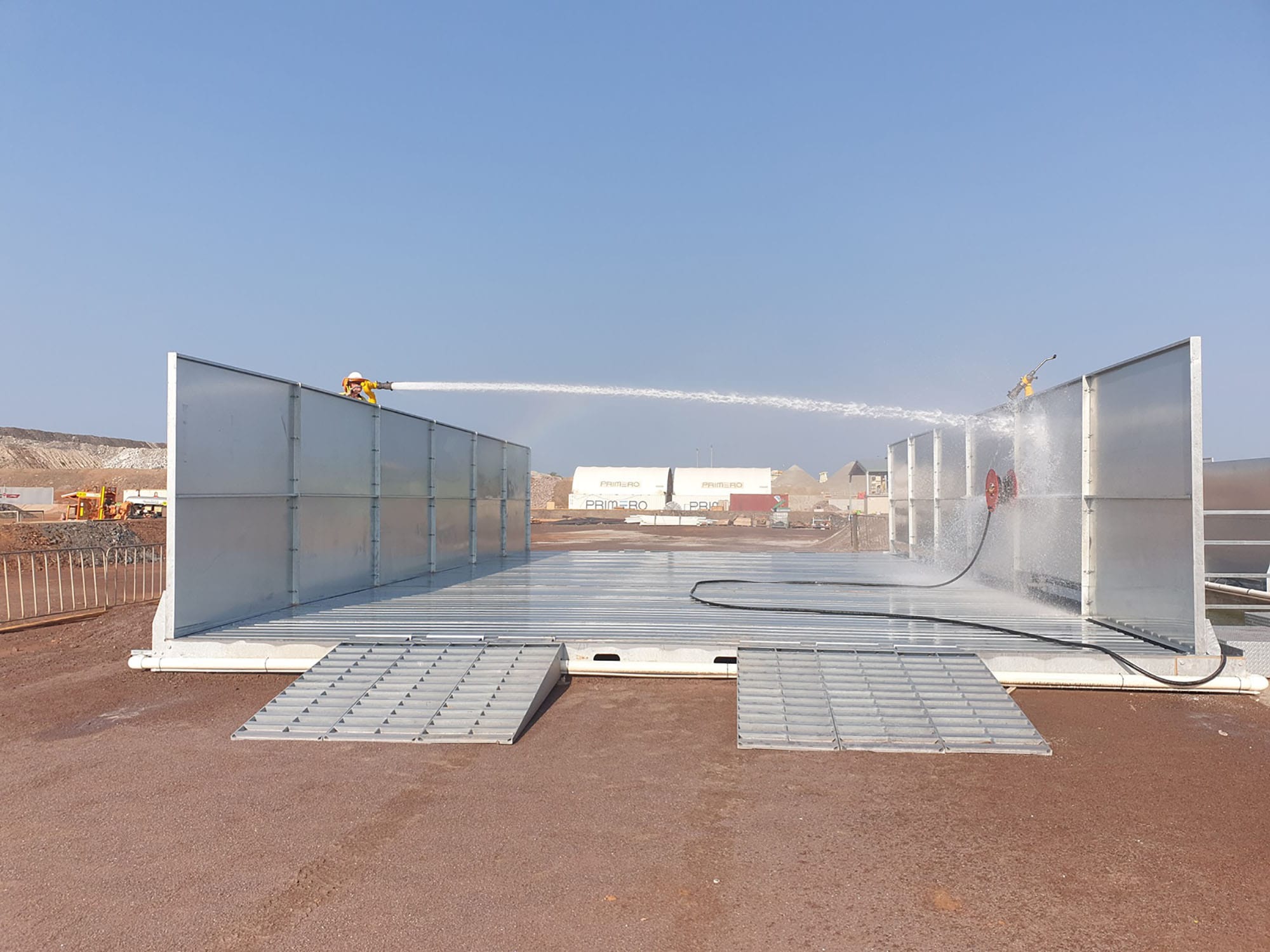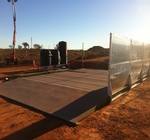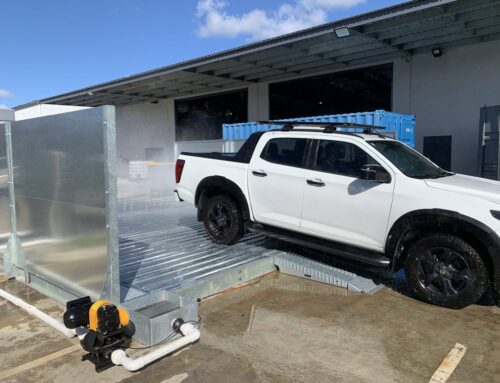You can build a compliant, efficient, and reliable wash bay even without a roof. In fact, many Australian operations—especially in remote or high-clearance environments—benefit significantly from open-air, roofless wash bay setups.
Struggling with inefficient wash systems causing downtime? Tired of generic setups and solutions that don’t suit your equipment or workshop? Unroofed wash bays offer flexibility, speed of deployment, and cost-efficiency—without compromising on compliance or performance.
Whether you’re managing a vehicle wash for mining fleets, a construction site, or overseeing wastewater treatment at an equipment depot, an open wash bay design may be the best fit. Here’s how to set one up the right way.
How to Build a Compliant Outdoor Wash Bay – No Roof Needed
Building a roofless wash bay is completely achievable—but only if you implement the right infrastructure. Environmental compliance is mandatory, even outdoors. Local authorities require wastewater from any wash bay—open or covered, permanent or portable—to be properly collected, treated, and discharged. This means your wash bay design must integrate pre treatment, drainage, and water recycling and water treatment systems that meet all environmental and operational standards.
Here are the core components of a compliant unroofed wash bay:
- Containment bunding
- Graded wash bay floor
- Flush diversion system
- Oil water separators
- Holding tanks
- Water recycling systems
- Portable wash bay pads (if relocatable)
It’s not just about avoiding penalties. It’s about safeguarding your workshop or site operations and equipment from runoff-related damage, delays, or shutdowns due to non-compliance.
7 Design Features You Can’t Skip When Building an Open Wash Bay
Don’t let non-compliance put your operations at risk. A quality product starts with quality design. These seven features are critical when designing unroofed wash bays:
- Bund Walls or Barriers
Contain wash water within the wash bay area to prevent environmental contamination. - Graded Surface
Your wash bay floor must be properly sloped to channel wash water to silt traps, preventing pooling and unsafe working conditions. - Flush Diversion System
Separates the initial flush—typically the dirtiest water—from the rest of the cycle. This ensures effective pre treatment and avoids overloading downstream systems. - Oil Water Separator
Required under most Australian guidelines for any commercial vehicle or equipment wash system. It separates hydrocarbons before water is released or recycled. - Water Recycling Systems
Capture and treat wash water for reuse—essential in regions with water scarcity or strict discharge requirements. Water recycling systems also cut water costs significantly. - Portable Wash Bay (If Applicable)
Relocatable setups allow rapid deployment and are ideal for remote or temporary sites, unlike permanent structures. - Structural Durability
All components must be weather-resistant and rated for heavy-duty use in exposed environments. Think galvanised steel, anti-slip coatings, and UV-resistant materials.
Ignoring even one of these components can result in environmental breaches or inefficiencies that cost you time and money.
Must-Have Infrastructure for a Reliable, Roofless Wash Bay
Even without a roof, a professional-grade wash bay must include a full system to manage wash water efficiently. Here’s what’s non-negotiable:
| Component | Function |
| Wash bay floor | Directs runoff to drainage and treatment units |
| Silt traps | Remove sediment and solid particles early on |
| Holding tanks | Temporarily store wastewater for treatment |
| Flush diversion system | Separates high-contaminant first flush water |
| Oil water separator | Separates oils and hydrocarbons |
| Water treatment systems | Recirculate or discharge water in compliance |
| Portable wash bay pads | Allow relocatability and minimise groundworks |
Whether your setup is in-ground, permanent, portable, or above-ground, this infrastructure ensures your site or workshop stays compliant, clean, and operational across a wide range of industrial activities.
Stop Runoff Issues Before They Start: Outdoor Washwater Management
Runoff management is the single biggest challenge in an unroofed wash bay. Open-air setups expose your system to rainfall, wind, and other environmental variables that increase the volume and complexity of wash water.
To avoid breaches:
- Use bunded containment zones around your wash bay
- Ensure all surfaces are graded toward collection points
- Include equipment like silt traps and catch pits in your drainage system
- Install automated or manual first-flush systems
- Regularly clean and maintain filters, traps, and holding tanks
Wash water must never enter storm drains untreated. Doing so could trigger penalties or enforcement action from the local authority, particularly in zones near local residents or environmentally sensitive sites.
Which Surface Works Best? Drainage & Flooring Tips for Open Bays
The right surface can make or break your wash bay. For open-air designs, the wash bay floor must be:
- Non-permeable
- Chemical-resistant
- Anti-slip (especially when wet)
- Graded toward drainage
Common flooring choices include hot-dip galvanised steel in modular systems, or sealed concrete with polyurethane coating for fixed or permanent sites. Avoid gravel or porous asphalt—these fail to contain wash water and will not pass compliance audits.
Drainage should include:
- Perimeter channels
- Grated trench drains
- Internal silt traps
- Access points for easy maintenance
Rainfall events can overwhelm poor drainage designs. Plan ahead for volume spikes and include overflow routing to secondary holding tanks or treatment systems.
Outdoor Water Treatment Systems That Actually Deliver Results

Not all water treatment systems are built for outdoor, unroofed environments. The right system will treat large volumes of wash water quickly, reliably, and in extreme weather.
The best systems combine:
- Pre-treatment (silt traps, filters)
- Oil separation (coalescing plate or vertical gravity units)
- Filtration (media, bag, or cartridge)
- Disinfection (UV or chlorination)
- Water recycling loops (for reuse)
Some systems come in plug-and-play skids or modular containers for quick site or workshop integration. Others are custom-designed to handle complex mixtures from car wash facilities, heavy equipment washdowns, construction sites, or degreasing operations.
Choose solutions built in Australia for Australian conditions. Contact EnviroConcepts today! Local support means quick construction, faster service, easier upgrades, and full accountability.
Tough Gear Only: Best Weather-Resistant Equipment for Open Bays
Outdoor wash bays demand equipment that can handle sun, wind, rain, and high use. That means:
- Galvanised steel construction
- UV-stabilised components
- Sealed electrical controls
- Industrial-grade pumps and motors
- Fully rated bunding and connections
From pressure washers to oil water separators, only invest in equipment or gear designed for outdoor operation. Avoid overseas imports with incompatible voltage, poor parts availability, or delayed support. Local Australian-made systems offer longer life cycles and faster resolution when things go wrong.
Avoid Penalties: Know These Environmental Rules for Open Wash Bays
Operating a wash bay in the open does not exempt you from environmental regulation. In fact, it often invites closer scrutiny. Here are rules you must follow:
- All wastewater must be collected, treated, or transported off-site.
- No untreated water can enter stormwater systems or natural ground.
- If you discharge to the sewer, you must obtain a trade waste permit from your local authority.
- Systems must be designed to handle average rainfall volumes (and overflow scenarios).
- Oil water separators must comply with relevant AS standards.
- Water treatment must reduce pollutants to acceptable discharge levels.
Contact your local council or state EPA before commissioning your system. They can advise on specific site requirements based on zoning, proximity to waterways, and population density.
Make It Work: Expert Tips for Running a No-Roof Wash Bay Smoothly
Make your unroofed wash bay as seamless as any indoor facility. Follow these expert strategies:
- Install a pre-use checklist for silt traps and flush diversion valves
- Use motion-triggered shutoffs or hose guns to avoid water waste
- Train staff on environmental procedures and first response in case of spills
- Schedule weekly maintenance for screens, pumps, and tanks
- Use remote monitoring or telemetry for tank levels and recycling performance
The best operations run their outdoor wash bays like a production line. Consistent processes equal compliance and efficiency.
The Real Pros & Cons of Open Wash Bays (And How to Tip the Scales in Your Favor)
Pros:
- Lower installation costs
- Faster deployment
- Better access for large vehicles
- Easier to relocate or upgrade
- No need for building permits in some cases
Cons:
- Exposure to rain increases wastewater volume
- Requires robust environmental controls
- Slightly higher maintenance (cleaning, filters)
- Risk of wash interruptions during extreme weather
How to tip the scales:
- Use a portable wash bay system instead of a permanent one for flexibility
- Design for worst-case weather events
- Automate as much as possible
- Choose local suppliers for fast support
With the right design, an unroofed wash bay can be just as effective—and often more practical—than traditional permanent setups.
No Roof, No Worries: Smart Cleaning Solutions for Open-Air Sites
Operating in the open? You’re not alone. Across Australia, more industries are embracing unroofed wash bays as a fast, flexible way to manage heavy-duty vehicle and workshop cleaning—especially on dynamic construction sites and remote depots.
But without a roof, your wash bay needs to work smarter. Weather, runoff, and compliance challenges can complicate even routine washes. That’s why choosing the right solutions for open-air setups is essential.
Here’s how to make your roofless wash bay thrive:
Rain-Ready Systems
In open wash bays, sudden downpours are part of the game. Choose cleaning systems designed to handle excess water—like automated first-flush diversion, bunded containment, and overflow routing to temporary holding tanks. These aren’t just features—they’re your frontline defense against environmental breaches.
Construction-Specific Flexibility
On construction sites, change is constant. That’s why relocatable wash bays, modular water treatment units, and scalable drainage setups are game-changers. You can reposition them as your site evolves—no need for fixed or permanent infrastructure.
Vehicle Wash Efficiency Without a Roof
Cleaning a fleet in the open? Whether it’s 4WDs, excavators, or trucks, your vehicle wash needs to be fast and compliant. High-pressure spray systems, oil-water separators, and mobile treatment skids help reduce downtime—even under the harshest conditions.
Keep the Workshop Compliant Outdoors
Outdoor workshop operations—like tool rinsing, parts washing, or equipment degreasing—can also be integrated into your roofless bay. Just make sure your system includes spill control, bunding, and regular filter maintenance to meet environmental standards.
Need Help? Contact the Experts
If you’re unsure what your site needs, don’t guess—contact our team. We’ll assess your location, environmental requirements, and wash-down volume to deliver tailored, compliant solutions.
When your wash bay has no roof, you can’t afford gaps in performance or compliance. Equip your site or workshop with robust, mobile, and intelligent cleaning solutions designed for the realities of open-air construction, vehicle, and workshop operations.
You Don’t Need a Roof to Operate a Compliant Wash Bay
Australian operations are ditching permanent infrastructures and turning to portable, unroofed wash bays to save time, meet compliance, and get the flexibility they need. Discover custom wash bays made right here in Australia. From portable wash bay setups to advanced water recycling systems, EnviroConcepts offers solutions engineered for your industry.
Ready to boost efficiency with tailored water treatment systems?
Let’s talk. Contact EnviroConcepts today for a tailored quote or a site consultation. You can also browse our case studies and FAQs for more insights into how we’ve helped over 500 Australian businesses stay compliant and efficient with our tailored solutions.





